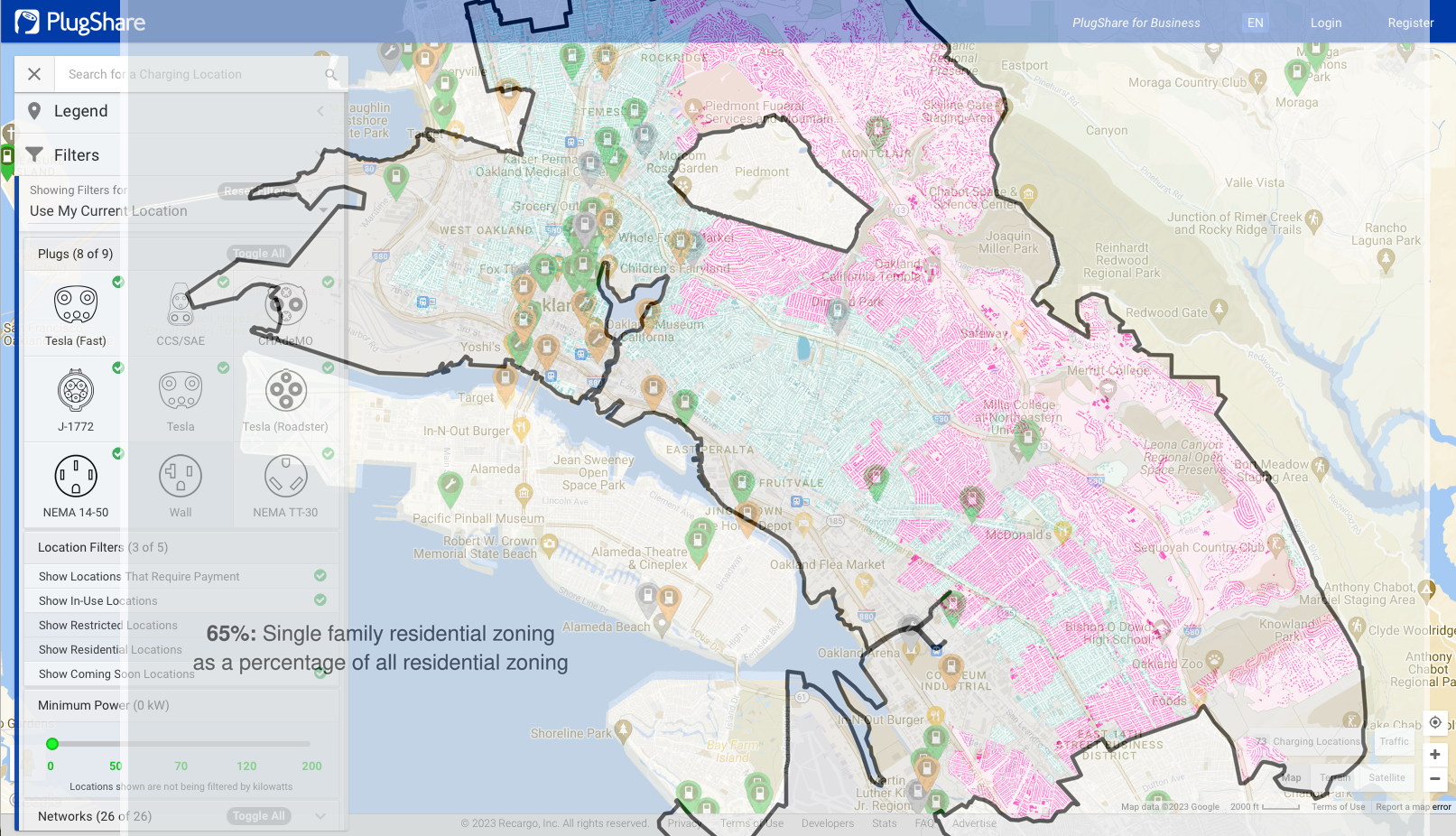On Supercharging the Streetlight
Photo by Rick Govic on Unsplash
Primer — EV Chargers Are Built Environment
I’ve been talking to a friend about EV charging — in particular, curbside charging. Although this Substack isn’t focused on the clean vehicle transition, I believe that decarbonization requires a comprehensive look into the intersection of other areas of emissions reduction. And while clean transportation is a critical element in every major climate change scenario (accounting for 27% of total US emissions), my interest in EVs is the physical infrastructure. Since 1 in 7 new vehicles purchased globally is now electric, there is growing pressure on public infrastructure to adapt to greater loads and on our buildings to provide the chargers. In coming years, the connection between EVs and the built environment will becoming increasingly bound as technologies like vehicle-to-grid (V2G) charging continue to play a critical role in urban energy usage.
Charging in Oakland
A quick search on PlugShare would show you that Oakland, which counts nearly 170,000 households, has only 253 public charging stations. When data shows that 20% of chargers are reported broken and that the primary reason EV drivers don’t charge in public is due to charger issues, it’s easy to understand why more than 80% of charging happens at home.
But what happens when you live in a multi-family dwelling (MFD) with limited access to EV charging? Oakland, which is home to 65% single-family housing, is one case that closely mirrors the distribution of zoning types in America, where 30% of households are MFD. And in Oakland, despite rapid EV adoption, public charging stations are often broken, guarded in private garages, or completely absent.
Oakland EV Chargers x Oakland Zoning Map
Oakland Zoning Map by Othering & Belonging Institute | Oakland EV Charger Map by PlugShare
By overlaying zoning data from the Othering & Belonging Institute on PlugShare’s charger network map, it’s easy to see how the distribution of EV chargers are inequitably consolidated in Downtown, Uptown, and Temescal, where high-rise apartment buildings are plenty and new premium condos are slated for development. Looking further east from Highland Park to Seminary, and you see a blanket of multi-family housing sitting in a desert charging, leaving low-to-middle-income Oaklanders with no access to chargers and little incentive to purchase an EV. In the face of growing public pressure to transition to clean energy and transportation, how will cities equitably support EV adoption?
An Uphill Battle for Multi-Family Charging
Despite growing demand from multi-family residents and the opportunity to increase property value, there is equal pressure on property owners to avoid installing EV chargers. A 2021 study from the Atlas Public Policy highlights drivers, barriers, and recommendations to adopt EV charging in MFD, citing specifically:
Complex and time-consuming installations for owners, in some cases requiring wiring and service upgrades
Costly installation and ongoing maintenance with long payback periods, with costs close to $10,000 per port
General lack of awareness or desire from owners of older property
Managing and offsetting increases in electricity costs and billing
Although new multi-family construction projects are subject to ICC provisions that require apartment communities provide EV charging for up to 20% of lots, existing MFD property owners aren’t impacted by the new provision. And while some EV charging companies are finding success with charger leasing programs, assisting with acquiring government incentives, or sophisticated software focused on earning passive income, there are options outside the building.
More Charging, More Parking
Just this week, on March 14, the USDOT opened applications for the Charging and Fueling Infrastructure Discretionary Grant Program (CFI), a $2.5 billion, five-year program focused on supporting community and neighborhood EV charging infrastructure. The CFI program will fund cities, counties, local governments, and tribes, starting with $700 million this year to focus on installing publicly accessible charging locations and enhancing the Alternative Fuel Corridor, another program that provides access to EV charging (among other alternative fuels) along major highways.
Here’s the thing, while community EV charging lots would benefit low-income access to critical EV infrastructure, this program competes directly with housing policy over land use and further delays long-term mass transit programs in favor of personal vehicles.
Mounting pressure from pro-housing advocates are demanding that local governments abolish parking minimums, and they’re winning. Last September, AB 2097 passed, setting precedent for new multi-family construction without parking mandates, which has had rippling effects in cities across the country from Minneapolis to New York. As a pro-housing advocate, I can’t say I disagree. While improving access to EVs for all socio-economic citizens is critical for a global transition to clean energy, we can’t favor short-term improvements at the expense of a future of transit oriented communities.
Supercharge the Streetlight
I haven’t found a compelling solution, company, or successful government program in the US that focuses on curbside chargers, but if you know of one, let me know.
Build the Future Wayfinder - Ubitricity creates public EV charging for everyone, everywhere
Over the past few months, I’ve thought about ways that cities could expand access to chargers across the country, but I was stuck. Whether it was installation barriers for MFD property owners, a peer-to-peer charging network, or relying on corporations like GM or public utilities to provide access, they all seemed to be limited by creeping land use and individual decision makers.
So I turned to the EU for inspiration, where EV adoption has outpaced the US, and learned about personal EV charging cords, streetlight retrofits, and curbside charging. Ubitricity, now owned by Shell, is focused on turning lampposts into EV chargers, making use of existing infrastructure and retrofitting a 5kW charger to curbside street lights all over the UK. With an install time of less than 2 hours per lamp post, this is the type of low-cost, low-effort private program that makes use of existing public parking space, reduces land use dedicated to cars, and keeps focus on the urban environment — not the bright LEDs that turn quiet city streets into a scene from Blade Runner.
A lamppost EV charger in Liverpool by Ubitricity
Yes, 5kW isn’t DC fast-charging, but it’s an immediate solution to an immediate need, which provides broad, equitable access to charging for all zoning types with a limited physical footprint. With a quick search, I found that solutions like this are starting to come to the US with local government support in Seattle and private-public partnerships in LA.
As cities across the country begin to plan optimal locations for EV fast-charge hubs and Level 2 curbside charging, urban planning tools will not only be critical in helping to address the equitable distribution of chargers, but also finding ways to incorporate charging into existing infrastructure to reduce the impact on urban environments and housing agendas.
This post was originally published at https://build.substack.com on March 14, 2023.







